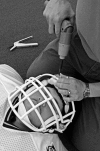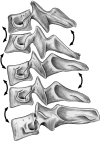National athletic trainers' association position statement: acute management of the cervical spine-injured athlete
- PMID: 19478836
- PMCID: PMC2681208
- DOI: 10.4085/1062-6050-44.3.306
National athletic trainers' association position statement: acute management of the cervical spine-injured athlete
Abstract
Objective: To provide certified athletic trainers, team physicians, emergency responders, and other health care professionals with recommendations on how to best manage a catastrophic cervical spine injury in the athlete.
Background: The relative incidence of catastrophic cervical spine injury in sports is low compared with other injuries. However, cervical spine injuries necessitate delicate and precise management, often involving the combined efforts of a variety of health care providers. The outcome of a catastrophic cervical spine injury depends on the efficiency of this management process and the timeliness of transfer to a controlled environment for diagnosis and treatment.
Recommendations: Recommendations are based on current evidence pertaining to prevention strategies to reduce the incidence of cervical spine injuries in sport; emergency planning and preparation to increase management efficiency; maintaining or creating neutral alignment in the cervical spine; accessing and maintaining the airway; stabilizing and transferring the athlete with a suspected cervical spine injury; managing the athlete participating in an equipment-laden sport, such as football, hockey, or lacrosse; and considerations in the emergency department.
Keywords: catastrophic injuries; emergency medicine; neurologic outcomes.
Figures












Similar articles
-
Summary of the National Athletic Trainers' Association position statement on the acute management of the cervical spine-injured athlete.Phys Sportsmed. 2009 Dec;37(4):20-30. doi: 10.3810/psm.2009.12.1738. Phys Sportsmed. 2009. PMID: 20048537
-
Cervical spine injury management in the helmeted athlete.Curr Sports Med Rep. 2011 Jan-Feb;10(1):45-9. doi: 10.1249/JSR.0b013e3182073767. Curr Sports Med Rep. 2011. PMID: 21228651 Review.
-
Consensus Recommendations on the Prehospital Care of the Injured Athlete With a Suspected Catastrophic Cervical Spine Injury.J Athl Train. 2020 Jun 23;55(6):563-572. doi: 10.4085/1062-6050-0434.19. J Athl Train. 2020. PMID: 32579668 Free PMC article.
-
Catastrophic cervical spine injuries in the collision sport athlete, part 1: epidemiology, functional anatomy, and diagnosis.Am J Sports Med. 2004 Jun;32(4):1077-87. doi: 10.1177/0363546504265605. Am J Sports Med. 2004. PMID: 15150061 Review.
-
Consensus Recommendations on the Prehospital Care of the Injured Athlete With a Suspected Catastrophic Cervical Spine Injury.Clin J Sport Med. 2020 Jul;30(4):296-304. doi: 10.1097/JSM.0000000000000869. Clin J Sport Med. 2020. PMID: 32639439
Cited by
-
Removal time and efficacy of Riddell Quick Release Face Guard Attachment System side clips during 1 football season.J Athl Train. 2012 Jul-Aug;47(4):421-7. doi: 10.4085/1062-6050-47.4.07. J Athl Train. 2012. PMID: 22889658 Free PMC article.
-
Youth Tackle Football Head-Impact Estimation by Players and Parents: Is the Perception the Reality?J Athl Train. 2023 Apr 1;58(4):285-292. doi: 10.4085/1062-6050-0560.21. J Athl Train. 2023. PMID: 35475900 Free PMC article.
-
Prevalence and Outcomes of Exposure to Catastrophic Events Among Athletic Trainers.J Athl Train. 2018 Nov;53(11):1098-1102. doi: 10.4085/1062-6050-533-17. Epub 2018 Dec 3. J Athl Train. 2018. PMID: 30507308 Free PMC article.
-
Quantitative Approach Based on Wearable Inertial Sensors to Assess and Identify Motion and Errors in Techniques Used during Training of Transfers of Simulated c-Spine-Injured Patients.J Healthc Eng. 2018 Mar 5;2018:5190693. doi: 10.1155/2018/5190693. eCollection 2018. J Healthc Eng. 2018. PMID: 29692881 Free PMC article.
-
Controlled Laboratory Comparison Study of Motion With Football Equipment in a Destabilized Cervical Spine: Three Spine-Board Transfer Techniques.Orthop J Sports Med. 2015 Sep 8;3(9):2325967115601853. doi: 10.1177/2325967115601853. eCollection 2015 Sep. Orthop J Sports Med. 2015. PMID: 26535397 Free PMC article.
References
-
- National Spinal Cord Injury Statistical Center. Spinal Cord Injury: Facts and Figures at a Glance. Birmingham: University of Alabama, Birmingham; 2006. p. 2.
-
- Nobunaga A, Go B.K, Karunas R.B. Recent demographic and injury trends in people served by the Model Spine Cord Injury Case Systems. Arch Phys Med Rehabil. 1999;80(11):1372–1382. - PubMed
-
- Mueller F, Cantu R. National Center for Catastrophic Sport Injury Research: Twenty-Fourth Annual Report: Fall 1982–Spring 2006. Chapel Hill: University of North Carolina; 2008.
-
- Mueller F.O, Cantu R.C. Annual Survey of Catastrophic Football Injuries, 1977–2006. Chapel Hill: University of North Carolina; 2006.
-
- Boden B.P, Tacchetti R.L, Cantu R.C, Knowles S.B, Mueller F.O. Catastrophic cervical spine injuries in high school and college football players. Am J Sports Med. 2006;34(8):1223–1232. - PubMed
LinkOut - more resources
Full Text Sources

